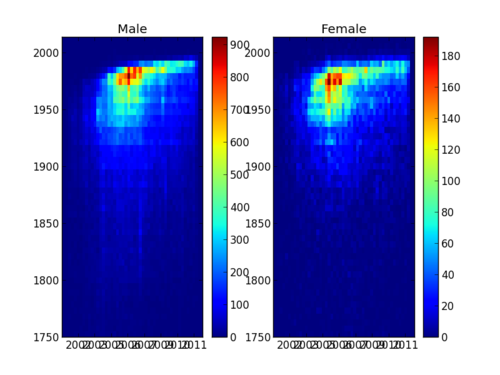Matplotlib: Difference between revisions
From CommunityData
m (Benjamin Mako Hill moved page Community Data Science Workshops (Fall 2014)/Day 3 projects/Matplotlib Session to Matplotlib) |
|||
| (15 intermediate revisions by 5 users not shown) | |||
| Line 1: | Line 1: | ||
[[File:Matplotlib-hist2d.png|right|500px]] | [[File:Matplotlib-hist2d.png|right|500px]] | ||
__NOTOC__ | __NOTOC__ | ||
== Visualizing data with Matplotlib | == Getting Started == | ||
Download the CDSW Matplotlib code from [https://github.com/makoshark/matplotlib-cdsw/archive/master.zip here] and unzip it on your machine. | |||
We will also need the data file that is [http://communitydata.cc/~mako/hp_wiki.tsv here] | |||
== Visualizing data with Matplotlib == | |||
In this session, we will explore how to produce clear, informative charts, graphs, and plots with [http://matplotlib.org/ Matplotlib], the most popular toolkit for scientific data visualization in Python. | In this session, we will explore how to produce clear, informative charts, graphs, and plots with [http://matplotlib.org/ Matplotlib], the most popular toolkit for scientific data visualization in Python. | ||
We'll | We'll start with the data-set created [[Community_Data_Science_Workshops_(Fall_2015)/Day_3_Lecture|this morning]] containing information about edits to the Harry Potter Wikipedia article. | ||
We will then proceed to visualize different aspects of data from the [[Community_Data_Science_Workshops_(Fall_2015)/Day_2_Projects/Socrata|Socrata web API]]. | |||
=== Inspiration === | |||
* [https://flowingdata.com/ Flowing Data] | |||
* [http://www-01.ibm.com/software/analytics/many-eyes/ Many Eyes] | |||
* [http://www.edwardtufte.com/tufte/ Edward Tufte] | |||
* [http://www.visualizing.org/ visualizing.org] | |||
* [http://idl.cs.washington.edu/ UW Interactive Data Lab] | |||
=== Goals === | === Goals === | ||
| Line 19: | Line 33: | ||
* Exercise your creativity by making your own visualization | * Exercise your creativity by making your own visualization | ||
# First plot: <tt>001-hello-plot.py</tt> | |||
# Subplots: <tt>002-subplots.py</tt> | |||
# Let's do something more interesting: <tt>003-plot-timeseries.py</tt> | |||
# Visit the [http://matplotlib.org/gallery.html Matplotlib gallery]. | |||
# Make another kind of plot: <tt>004-plot-histogram.py</tt> | |||
# Dive deeper into web APIs: <tt>005-traffic-timeseries.py</tt> | |||
# Play around with any/all the data you've seen! You can find some more examples in the <tt>wikibios</tt> folder. | |||
=== References === | === References === | ||
| Line 32: | Line 46: | ||
* [http://matplotlib.org/examples/index.html matplotlib Examples] (many, with source) | * [http://matplotlib.org/examples/index.html matplotlib Examples] (many, with source) | ||
* Other plotting resources | * Other plotting resources | ||
** [http://web.stanford.edu/~mwaskom/software/seaborn/ Seaborn]: fancy matplotlib-based visualizations | ** [http://web.stanford.edu/~mwaskom/software/seaborn/ Seaborn]: fancy matplotlib-based visualizations | ||
** [http://ggplot.yhathq.com/ ggplot]: port of the R language's ggplot2 library to python | ** [http://ggplot.yhathq.com/ ggplot]: port of the R language's ggplot2 library to python | ||
| Line 48: | Line 61: | ||
[[File:Wikipedia.png|right|250px]] | [[File:Wikipedia.png|right|250px]] | ||
[[Category:CDSW]] | |||
Latest revision as of 18:22, 7 May 2016
Getting Started[edit]
Download the CDSW Matplotlib code from here and unzip it on your machine.
We will also need the data file that is here
Visualizing data with Matplotlib[edit]
In this session, we will explore how to produce clear, informative charts, graphs, and plots with Matplotlib, the most popular toolkit for scientific data visualization in Python.
We'll start with the data-set created this morning containing information about edits to the Harry Potter Wikipedia article.
We will then proceed to visualize different aspects of data from the Socrata web API.
Inspiration[edit]
Goals[edit]
- Get set up to make graphs with Matplotlib
- Learn the basics of the Matplotlib API and workflow
- Practice reading the Matplotlib documentation
- Build a plotting program step by step
- Learn simple ways to distill the essence of a large data set
- Explore the art of visualizing data
- Exercise your creativity by making your own visualization
- First plot: 001-hello-plot.py
- Subplots: 002-subplots.py
- Let's do something more interesting: 003-plot-timeseries.py
- Visit the Matplotlib gallery.
- Make another kind of plot: 004-plot-histogram.py
- Dive deeper into web APIs: 005-traffic-timeseries.py
- Play around with any/all the data you've seen! You can find some more examples in the wikibios folder.
References[edit]
- matplotlib API reference
- matplotlib Examples (many, with source)
- Other plotting resources
Example topics to cover in Lecture[edit]
- line charts
- histograms
- binning
- scatter plots
- heat maps
- axis labeling
- legends


